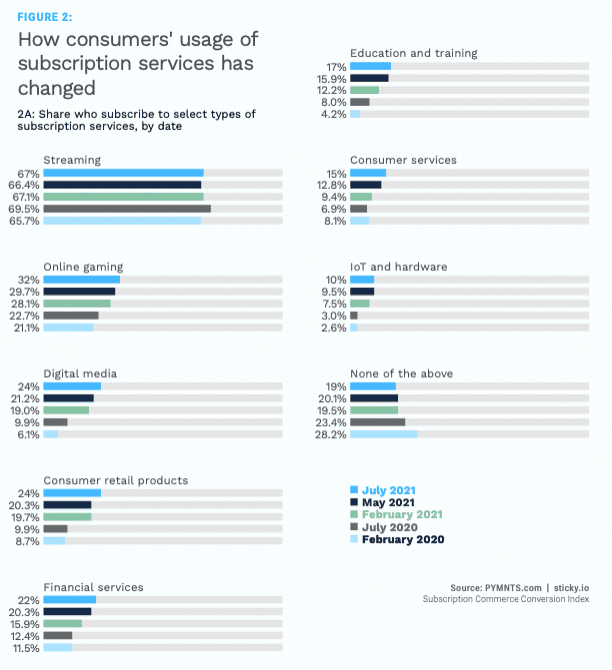As Business Model Matures, B2B Subscriptions Have Become Hot Growth Area

Over the last two years, the rate at which consumers sign up for subscriptions has jumped significantly, leading some companies to consider the model for their business-to-business (B2B) relationships as well.
Russell Klein, chief commercial officer at BigCommerce, noted that businesses are constantly looking for predictability in their vendor and client relationships, which makes subscriptions appealing, especially as more commerce moves online.
“It comes down to de-risking this relationship, extending out the lifetime value and then carving up that pie a little bit,” Klein told PYMNTS in a recent interview. “If I as a seller can get more lifetime value, then on the flip side, I can either keep that or give part of it back in the form of discounts, rebates or other ways to keep that customer — who’s given me their money on a regular basis — that much happier.”
To that end, BigCommerce is partnering with Chargify, a billing and subscription management tool for B2B Software-as-a-Service (SaaS) companies, to provide merchants using the eCommerce software platform a way to manage, track and analyze subscription activity to decrease churn and strengthen customer relationships. The integration will allow both direct-to-consumer (D2C) and B2B merchants to sell products on subscription directly through their BigCommerce store, removing the need to change third-party systems.
“The more you have these solution providers that take the challenge out of it and present it in an easy onboarding, friction-free manner, the more we’ve seen a significant bending of the curve of merchants testing out subscriptions,” Klein said.
Barrow Hamilton, chief product officer at Chargify, told PYMNTS that his company has seen an acceleration of subscription activity over the past 18 months, “as more and more businesses understand the value they can provide to their customers in a recurring subscription model.” The partnership with BigCommerce, he said, works well because of how the companies complement each other.
“We have the ability to do an integration like this very seamlessly to create a great experience for customers of BigCommerce that want to also offer subscription services as part of their overall offerings in the market,” Hamilton said.
PYMNTS research, conducted in collaboration with sticky.io, found that 81% of Americans now subscribe to at least one subscription service, a 13% increase since February 2020. Two-thirds of consumers have a streaming service subscription, while 32% have a subscription for online gaming and 24% have one for consumer retail products.
 See also: New Data Cites Flexibility, Discounts as Top Retail Subscription Churn Fighters
See also: New Data Cites Flexibility, Discounts as Top Retail Subscription Churn Fighters
“Subscriptions are not the panacea for 100% of the transactions or the transactional relationship with a customer,” Klein said. “But it’s surprising if you look around all the four corners of eCommerce how many different creative use cases there are, once there’s a trusted relationship.”
Overcoming Hurdles
One of the primary barriers for a business when moving to a subscription model is “the ability to execute,” Hamilton said, which means having a streamlined billing and invoicing system alongside a customer-friendly way to get people signed up.
“You can imagine as you scale up and you have hundreds of thousands of customers and they’ve all signed up for subscriptions on different dates, which dictate when things like renewals need to occur and invoices need to go out,” he said. “That, to me, is the biggest hurdle — just having the systems and operational processes in place.”
More than one-quarter of subscribers experienced a declined payment within the past 12 months, according to PYMNTS research, with only 68% of consumers who experience a declined payment updating their information to keep the subscription current. Another 17% let the subscriptions terminate, while 10% switched to a competing service provider.
FlexPay CEO Darryl Hicks told Karen Webster in a recent interview that companies need to be proactive about fixing failed payments, which account for 48% of churn. “We see that a lot of merchants think churn is happening in customer service or [because] people are dissatisfied with the product or service,” he said. “But if they’re not focused on the failed payments, they’re missing 48% of the problem.”
The top-decile performers, Hicks added, also “have a very data-driven approach” to identifying points of friction.
“[Payment authorization management and avoiding failed payments are] things that top-performing merchants really spend a lot of time thinking about,” he told Webster. “It’s typically someone on the finance team, or it might be someone on the product team who’s responsible for optimizing the P&L — but at a certain scale, there’s someone who’s focused on payment authorization management and looking at what we can do to make … our interactions with our customers as frictionless and seamless as possible.”
